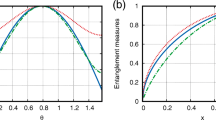In this paper recent work that attempts to link quantum entanglement to (i) thermodynamic energy, (ii) thermodynamic entropy and (iii) information is reviewed. With respect to the first two links the paper is essentially expository. The final link is elaborated on: it is argued that the value of the entanglement of a bipartite system in a pure state is equal to the value of the irreducible uncertainty (i.e. irreducibly missing information) about its subsystems and that this suggests that entanglement gives rise to irreducible uncertainty. (The exact meaning of the phrase “irreducible uncertainty”, as used here, is explained in the body of the paper. Roughly speaking, it is the uncertainty about the post-measurement state of a system that cannot be removed at the pre-measurement stage.) This analysis is used to make a further connection between entanglement and statistical mechanical entropy: it is argued that these properties are indirectly linked, in so far as both give rise to forms of uncertainty (albeit rather different forms of uncertainty about rather different things).
Similar content being viewed by others
References
Einstein A., Podolsky B., Rosen N. (1935) “Can quantum-mechanical description of physical reality be considered complete?”. Phys. Rev. Lett. 47, 777–780
E. Schrödinger, “The present situation in quantum mechanics,” (trans. J. D. Trimmer) reprinted in Quantum Theory and Measurement, J. A. Wheeler and W. H. Zurek, eds. (Princeton University Press, Princeton, 1983), pp. 152–167.
E. Schrödinger, “Discussion of probability relations between separated systems,” Proc. Cambridge Philos. Soc. 31, 555–563 (1935) and 32, 446–451 (1936).
Bell J.S. (1964) “On the Einstein–Podolsky–Rosen paradox”. Phys. 1, 195–200
Ghirardi G., Marinatto L. (2004) “General criterion for the entanglement of two indistinguishable particles”. Phys. Rev. A 70: 012109
Schumacher B. (1995) “On quantum coding”. Phys. Rev. A 51: 2738–2747
Popescu S., Rohrlich D. (1997) “Thermodynamics and the measure of entanglement”. Phys. Rev. A 56(5): R3319–R3321
Bennett C.H., Bernstein H.J., Popescu S., Schumacher B. (1996) “Concentrating partial entanglement by local operations”. Phys. Rev. A 53(4): 2046–2052
Donald M.J., Horodecki M., Rudolph O. (2002) “The uniqueness theorem for entanglement measures”. J. Math. Phys. 43, 4252–4272
Vedral V., Kashefi E. (2002) “Uniqueness of the entanglement measure for bipartite pure states and thermodynamics”. Phys. Rev. Lett. 89(3): 037903
Giles R. (1964) Mathematical Foundations of Thermodynamics. Pergamon, New York
Vedral V., Plenio M.B. (1998) “Entanglement measures and purification procedures”. Phys. Rev. A 57: 1619–1633
Horodecki M., Horodecki P., Horodecki R. (1998) “Mixed-state entanglement and distillation: is there a ‘bound’ entanglement in nature?”. Phys. Rev. Lett. 80, 5239–5242
Horodecki P., Horodecki R., Horodecki M. (1998) “Entanglement and thermodynamical analogies”. Acta Physica Slovaca 48, 141–156
Peres A. (1993) Quantum Theory: Concepts and Methods. Kluwer Academic, Dordrecht
Rohrlich D. (2001) “Thermodynamical analogues in quantum information theory”. Opt. Spectrosc. 91(3): 363–367
Shenker O.R. (1999) “Is –kTr(ρ ln ρ) the entropy in quantum mechanics?”. Brit. J. Phil. Sci. 50, 33–48
Henderson L. (2003) “The von Neumann entropy: a reply to Shenker”. Brit. J. Phil. Sci. 54, 291–296
Horodecki R., Horodecki M., Horodecki P. (2001) “Balance of information in bipartite quantum-communication systems: entanglement-energy analogy”. Phys. Rev. A 63: 022310
Horodecki K., Horodecki M., Horodecki P., Oppenheim J. (2005) “Information theories with adversaries, intrinsic information, and entanglement”. Found. Phys. 35(12): 2027–2040
Nielsen M.A., Chuang I.L. (2000) Quantum Computation and Quantum Information. Cambridge University Press, Cambridge,
Hughston L.P., Jozsa R., Wootters W.K. (1993) “A complete classification of quantum ensembles having a given density matrix”. Phys. Lett. A 183, 14–18
Author information
Authors and Affiliations
Corresponding author
Additional information
Communicated by Alwyn van der Merwe
Rights and permissions
About this article
Cite this article
Ainsworth, P.M. Untangling Entanglement. Found Phys 37, 144–158 (2007). https://doi.org/10.1007/s10701-006-9095-3
Received:
Revised:
Published:
Issue Date:
DOI: https://doi.org/10.1007/s10701-006-9095-3




